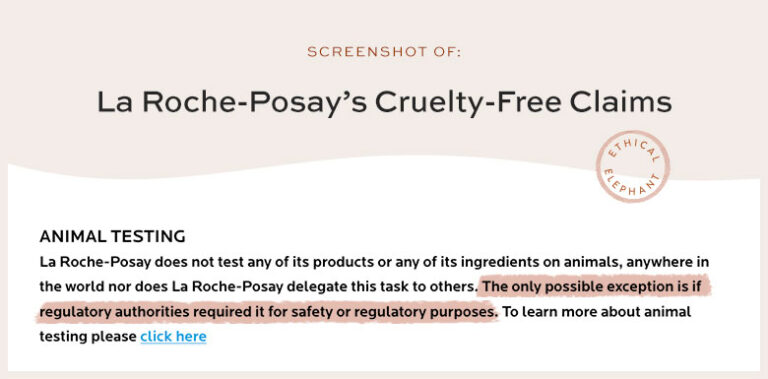As consumers become more critical of product sourcing and ethical standards, the question of animal testing in the beauty industry grows increasingly complex. A prominent name at the intersection of this debate is La Roche-Posay, a brand known for its skincare products developed for sensitive skin. However, as awareness of ethical consumption rises, the inquiry looms—Is La Roche-Posay truly cruelty-free, or does its parent company, L’Oréal, taint its ethical image?
The term “cruelty-free” has gained traction as a buzzword among consumers, yet its interpretation can be nebulous. Brands that advertise themselves as such often do so with a commitment to not testing their products on animals; nevertheless, the complicating factor arises when parent companies establish their own testing protocols. In the realm of La Roche-Posay, which operates under the umbrella of L’Oréal, the inquiry becomes even more intricate. L’Oréal’s extensive portfolio encompasses numerous brands, and its testing policies warrant scrutiny.
To understand the landscape better, we first need to explore the essence of what it means to be cruelty-free. The term generally denotes a pledge to ensure that neither the products nor the individual ingredients have undergone testing on animals at any point in the production chain. For many consumers, it also includes a commitment to transparency—an openness about sourcing practices, ingredient origins, and overall ethical considerations. This set of expectations raises a compelling conversation around the practices employed by larger corporations.
La Roche-Posay’s formulations consist of ingredients that are often lauded for their therapeutic properties. The brand emphasizes its mission to serve those with sensitive skin, providing solace for dermatological woes. Yet, the ethical implications of sourcing and testing become muddied once one realizes that L’Oréal conducts animal testing where required by law. This regulatory landscape varies dramatically from one nation to another; thus, the global market complicates the claim that La Roche-Posay is entirely cruelty-free.
For instance, in territories like China, animal testing is mandated for imported cosmetics. Since L’Oréal operates within these markets, it raises a pointed question: Are the profits gained from sales in these regions worth compromising on animal welfare? This dilemma places consumers who champion ethical practices in a precarious position. Should they support a beloved brand knowing that its parent company participates in practices they fundamentally oppose?
Moreover, it’s vital to consider the action of reformulating or redistributing products to local markets. Cruelty-free brands often navigate complex regulatory frameworks, seeking alternatives or exemptions. However, with L’Oréal’s vast prowess and influence, one wonders why a brand like La Roche-Posay hasn’t led a charge toward universal ethical standards. Could there be an underlying reluctance to disrupt sales in markets that practice animal testing? The juxtaposition presents an ethical paradox that demands consumer reflection.
Given these nuances, one might ask: What steps are consumers able to take to ensure their purchasing decisions align with their values? Many individuals now gravitate toward brands that have received third-party certifications, backing their cruelty-free claims. Such endorsements deliver a sense of trust and foster accountability.
However, La Roche-Posay adheres to a more ambiguous stance, claiming that it does not engage in animal testing for its products; nevertheless, its compliance with L’Oréal’s broader operational practices undermines this assertion. Transparency remains critical; without it, brands risk alienating conscientious consumers who seek alignment between their lifestyle choices and personal ethics.
Another avenue for ongoing discourse is the exploration of alternatives. As the cruelty-free movement matures, an influx of competitors arises, vigorously contesting market share against well-established brands like La Roche-Posay. New-age companies often champion ethical practices, boasting ingredient sourcing devoid of animal testing and eschewing any reliance on imposed regulatory frameworks. This outside competition could serve as a catalyst for change, pushing traditional companies to elevate their ethical stances and reevaluate their testing methods.
So, how can advocates for animal welfare make their voices heard? Writing letters, engaging in social media campaigns, and supporting cruelty-free initiatives foster a community of informed consumers. Petitions can galvanize collective efforts that press for legislative change and compel companies to adopt more conscientious practices. Moreover, sharing personal experiences with the products can illuminate the ethical concerns surrounding a brand’s practices and open a dialogue among peers.
In conclusion, while La Roche-Posay offers a prolific range of effective skincare solutions, its stance on animal testing is not without significant challenges. The nature of its parent company’s practices casts a long shadow over its advertised cruelty-free claims. As ethical consumers, we must weigh our desires against our moral convictions, recognizing that the choices we make extend beyond mere appearances. It is incumbent upon us to demand transparency and accountability, pressing brands to prioritize humane practices over profit margins. After all, each purchase serves as a vote for the type of world we wish to cultivate—one characterized by empathy, respect for all living beings, and an unwavering commitment to the greater good.








